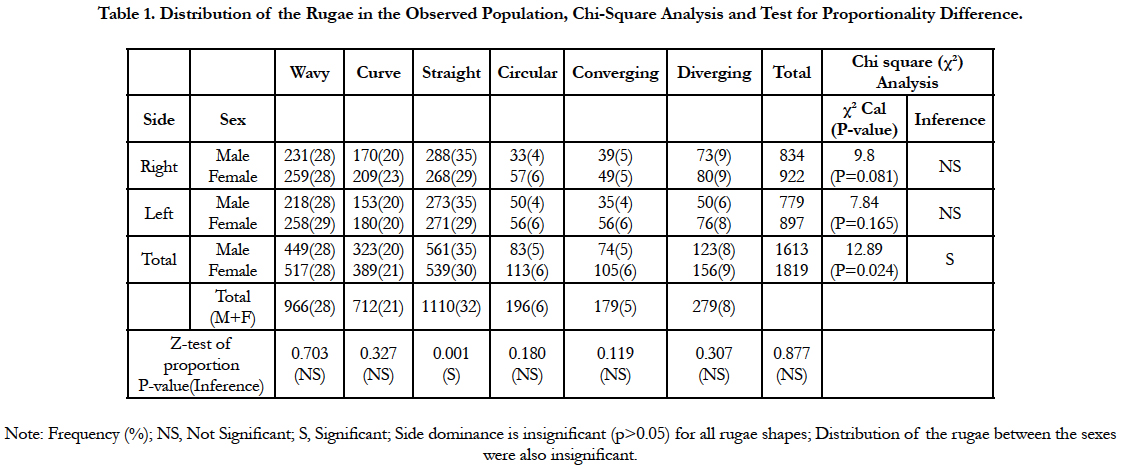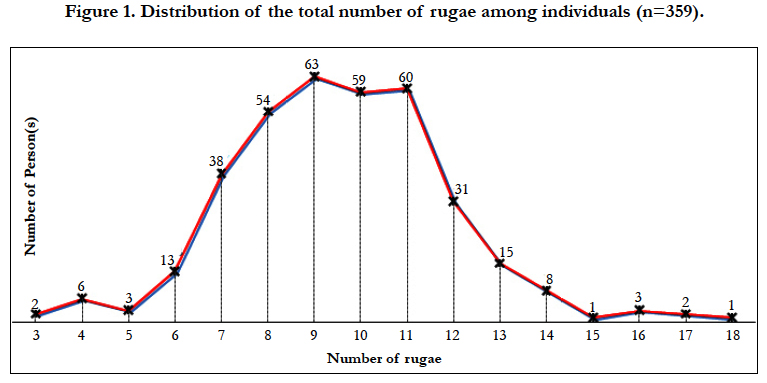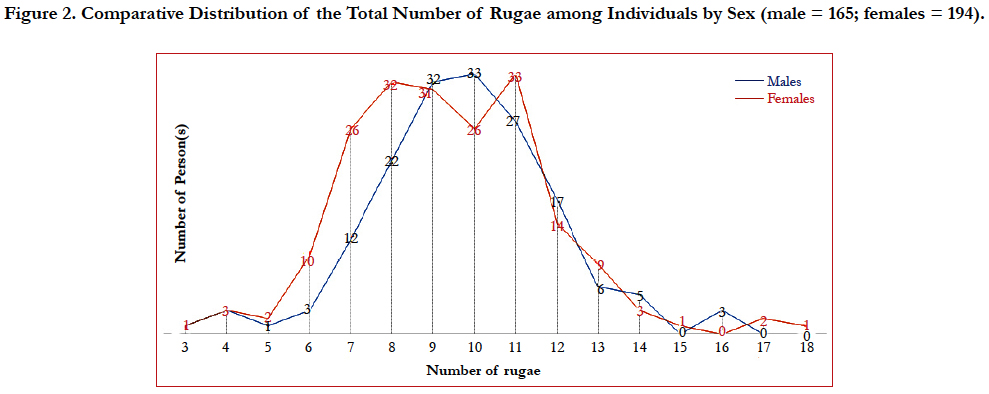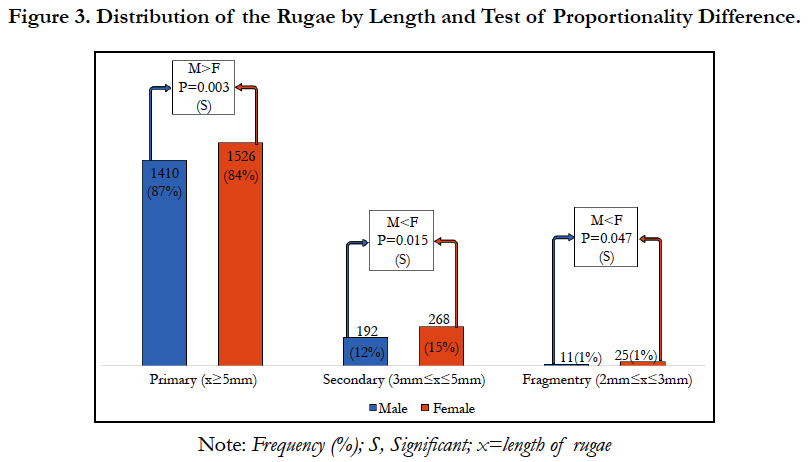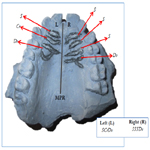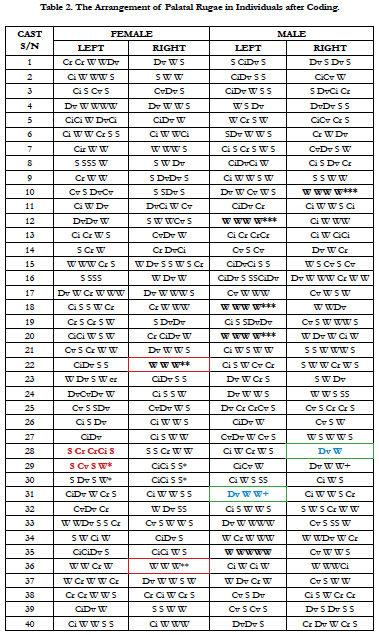Palatal Rugae Coding: Evaluating its Usefulness in Differentiating Sex and Establishing Identity
Aigbogun (Jr.) E.O1,2*, Ibeachu P.C2
1 Center for Occupational Health, Safety and Environment, Institute of Petroleum Studies, University of Port Harcourt, Rivers State, Nigeria. 2 Department of Anatomy, College of Health Sciences, University of Port-Harcourt, Rivers State, Nigeria.
*Corresponding Author
Aigbogun (Jr.) E.O
Center for Occupational Health, Safety and Environment,
Institute of Petroleum Studies, University of Port Harcourt, Rivers State, Nigeria.
E-mail: eric_aigbogun@uniport.edu.ng
Received: October 27, 2017; Accepted: November 06, 2017; Published: November 07, 2017
Citation: Aigbogun (Jr) EO, Ibeachu PC. Palatal Rugae Coding: Evaluating its Usefulness in Differentiating Sex and Establishing Identity. Int J Anat Appl Physiol. 2017;3(3):74-79. doi: dx.doi.org/10.19070/2572-7451-1700012
Copyright:Aigbogun (Jr) EO© 2017. This is an open-access article distributed under the terms of the Creative Commons Attribution License, which permits unrestricted use, distribution and reproduction in any medium, provided the original author and source are credited.
Abstract
Background: Under certain circumstances, the most common techniques used for establishing identity may not be applicable; hence, fast and reliable alternative methods would scientifically be welcomed.
Aim and Objectives: This study investigates the practical usability of palatal rugae in establishing sex and identity in a premortem state and evaluating its usefulness for post-mortem identification.
Materials and Methods: A total of 359 subjects, 165 males and 194 females between ages 20-60 years were selected from among volunteer subjects in Port Harcourt, Nigeria. Maxillary dental cast were formed by alginate impressions, the palatal rugae were traced using a high precision graphite HB pencil and then analyzed for their various patterns (using Thomas and Kotze, and Kapali’s classifications). The observed rugae were assigned the following codes; from anterior to posterior - Wavy (W), Curved (Cr), Straight (S), Circular (Ci), Converge (Cv), Diverging (Dv) for both sides of the palate.
Results: Statistical analysis using the Z-test for proportionality difference (males vs females) showed no significant difference in the distribution of the rugae shapes (P=0.877), Chi-square analysis of association showed insignificant distributive relationship with respect to sides (P<0.05); while sex and the distribution of all rugae types (by length) was significant (P<0.05). From the coding, the most common configuration was “WWWW” without duplicity of the pattern in any two individual; while in combination with other patterns, the straight was most frequent.
Conclusion: This research emphasizes the importance of the rugae configuration; as it is very difficult for sex differentiation but reliable for establishing the identity of an individual in both post- and pre-mortem state.
2.Introduction
3.Materials and Methods
3.1 Method of Identification
3.2 Shape of Rugae
3.3 Unification
3.4 Length of Rugae
3.5 Reducing Error in Cast Reading
3.6 Statistical Analysis
4.Result
4.1 Rugae Distribution
4.2 Rugae Coding System
5.Discussion
6.Conclusion
7.Acknowledgement
8.References
KeyWords
Human Identification; Sex Differentiation; Palatal Rugoscopy; Maxillary Dental Cast; Nigerians.
Introduction
Biometric data acquisition aids in personal identification, prevent record falsification and identity deft. Biometric records assists in comparative identification in both post-and pre-mortem situations. Forensic identification fundamentally is a multidisciplinary approach which relies on positive [1, 2] and accurate identification techniques as well as presumptive or evidential approaches involving proper handling and examination of findings [1].
In forensic medicine, the most methods used for identification are the DNA test, retina, fingerprints and dental characteristics. DNA testing is the gold standard in forensic science but it is very expensive and hence limited in case of mass disaster [3]; while the limitation of other methods have been documented in situations involving loss of anatomical features such as iris, soft tissue profile and finger prints as a result of charring or mutilation, extreme heat and decomposition [4, 5]. Therefore, any chosen method of identification that involves the above anatomical parts becomes ineffective and its outcome inconclusive.
The use of human palatal rugae has also been suggested as an alternative method of identification [3]. Palatal rugae, as a result of their internal position, are stable and well protected from trauma and high temperature by various anatomical structures surrounding it [6]. The rugae shapes are consistent regardless of aging [7] and resist putrefaction [2, 8, 9] upon death.
Personal identification is based on the arrangement and distribution of rugae patterns; as the palate is neither degenerated nor transformed when most of other anatomical structures are damaged, burned or dehydrated under certain circumstances. Hence this study is aimed at demonstrating the usability of rugae coding in differentiating sex and establishing identity in both preand post-mortem situations.
Materials and Methods
The alginate paste was prepared by mixing the alginate impression powder (Spofadental, A Kerr Company, LOT: 2302461) with water as instructed by the manufacturer. Maxillary arch impressions of the subjects were taken using perforated impression tray already mixed and loaded with alginate impression material. Dental casts were made with type 4 dental stone (Spofadental A Kerr Company, LOT: 4511215). The outlines of the rugae were traced on these casts using a sharp HB graphite pencil under acceptable lighting system [Figure 1]. The palatal rugae patterns were then analyzed on the casts with the help of magnifying lens, using the two classifications.
A total of 394 models were made, but 359 casts (92.1%) comprising of 165 (46.2%) male and 194 (53.8%) female cast of pure Nigerian nationality were selected, their ages ranging between 20-60 years. All subjects were healthy individuals free of congenital malformations, inflammation, trauma or history of orthodontic treatment. There was also no ethnic consideration in selection of subjects.
To record palatal rugae, the classification given by Thomas and Kotze [10] and Kapali et al., [11] were considered.
The shapes of individual rugae were classified into 4 major types:
1. Curve: The curved type had a simple crescent shape with a gentle curve.
2. Wavy: The wavy rugae were serpentine (snake-like) in shape.
3. Straight: The straight types ran directly from their origin to insertion.
4. Circular: They are classified as rugae that showed definite continuous ring formation.
This occurs when two rugae are joined at their origin or termination. Unification is classified into two categories;
5. Diverging: Rugae were considered to be diverging if two rugae had the same origin but immediately branched.
6. Converging: Rugae were considered to be converging if two rugae with different origins join on their lateral portions.
1. Fragmentary (2-<3mm)
2. Secondary (3-<5mm)
3. Primary (≥5mm)
Note: All rugae length below 2mm and directional orientation of the rugae were disregarded.
In other to reduce error in reading the cast, 4 research assistant (students) were trained to take the reading, the result of each of them were independent (they take the readings differently with same cast models). Inter-observer error was assessed by comparing the similarity of the readings from 4 research assistants (4 persons taking the reading gave the authors the opportunity to decide when a tie was reached); as the authors were more very conversant with rugae morphological arrangements and maneuvers. Using the digital vernier caliper, the length of the rugae were measured twice and the average documented as original length.
Total number of different types of rugae was counted for both the sides in both sexes and the total number of rugae distributed in the palate of each subject was also noted. Frequency and Percentages were used to present the total rugae patterns. Chisquare and two-sample z-test for proportionality difference were performed. P-value ≤ 0.05 was considered statistically significant. Microsoft excel 2013 was used to perform the various analysis.
Result
The results obtained are presented in the Tables 1 & 2; and graphical representation of data in Figure 1-4.
The total number of rugae distributed between males and females were 165 (1613 rugae) and 194 (1819 rugae). This proportionate distribution was found to be statistically in significant (Z=0.15; P=0.88) although with a higher proportion for females (0.107) than males (0.102). There were no significant differences (P>0.05) in the distribution with respect to the sides of the palate [Table 1].
As shown in [Table 1], in the total subjects (male + female) for the population studied, straight pattern (35%) was predominant followed by wavy (28%) and curved (21%), whereas converging (5%) was least common. The same pattern of dominance was observed in the sexes. As shown in Table 1, straight-shaped rugae pattern in the male subjects was significantly more (P=0.001), whereas the distribution of other shapes were insignificant (P>0.05). Chi-square analysis showed no significant association of sex with the distribution of the rugae shapes with respect to either sides (Right; P=0.08 and Left; P=0.17) but the distribution of the total rugae patterns in the palate was observed to have sexual undertone (P=0.02)[Table 1].
A total of 3432 rugae were counted with 165 males possessing 1613 rugae and a 194 females having 1819 rugae. On observation of the range of rugae of distribution; 3 rugae was the minimum and 18 rugae the maximum number of rugae presented on the dental cast of an indivdual [Figure 1]. In observing the total number of rugae per individual, 9 rugae was predominant, followed by 11 rugae and then 10 rugae in the studied population presented in the dental cast of 63, 60 and 59 individuals respectively [Figure 1]. Hence, 9 rugae was the modal range of rugae per individual for the studied population [Figure 1].
There was uneven distribution of rugae per individual in the sexes; the females exhibited the highest number of total rugae per individual with 2 females having 17 rugae each and 1 possessing 18 rugae while for the males, 16 rugae were observed in the dental cast of 3 persons [Figure 2].
The rugae were also classified into primary, secondary and fragmentary rugae based on their length; males recorded a higher percentage of primary rugae in males (1410; 87%) than females (1526; 84%) while the secondary and fragmentary rugae were lesser in males. The distribution and proportionality differences in the type of rugae (Length) between sexes were compared. Some degree of sex variability in the distribution was observed [Figure 3]. Females displayed a significantly high proportion of secondary (P=0.02) and fragmentary rugae (P=0.05) while males had significantly more primary rugaes (P=0.003) [Figure 3].
The various pattern were coded as follows: W-wavy, Cr-curve, S-straight, Ci-circular, Dv-diverging, Cv-converging. The coding was done from superior to inferior when place on a table or antrio-posterioly with reference to the oral cavity [Figure 4].
All maxillary dental cast collected were analyzed but only 40 were presented [Table 2] to demonstrate its individualistic nature. The coding of the various rugae in Table 2 demonstrates that; no two individual has the same rugae combination with respect to its pattern, number, position and location (arrangement). The combination and arrangement of cast 29 and 30 on right was identical (Ci Ci S S*) for the females but on close examination, the position of the 2nd rugae on the left is alternated by converging for Cast 29 (S Cν S W) and diverging for cast 30 (S Dν S W). It is also observed that Cast S/N 10, 12 and 18 for male subjects are having the same arrangement of wavy rugae on one side but on the other side, there arrangement pattern are not similar. After close observation of the arrangement pattern of the rugae the most common combination was “W” with varying number of presentation.
Discussion
The essence of personal data acquisition is to assemble the biological profile and establish identity of an individual. Maxillary dental cast is the most commonly investigated model in forensic odontology [1, 12, 13]; because it provides the platform for varying degree of simple and complex comparative analysis, it has a relative low production cost, the casts are easily available in both pictorial and model forms and also direct intra-oral observation may lead to errors.
Despite controversies about the qualitative and quantitative stability of rugae characteristic; and the extent of to which ethic and sexual difference exists, the uniqueness to individuals is un doubtable established in forensic science; mostly in personal identification [8, 10, 14-17].
In this study, considerably higher percentage of straight pattern was detected in both sexes. Female dominance in the total number rugae per individual was also observed. While analyzing palatal rugae patterns, no significant difference was found in the distribution of the different rugae patterns in males and females except for straight; also no pattern of rugae was peculiar to any sex. These findings are in line with the findings of Sharma et al., [14] Although the chi-square analysis of association indicated sexual influence in the distribution of the rugae, however no association was found in the distributions of the shapes between the sexes with respect to the presentation on the sides of the palate. These findings are not surprising as sexual dimorphism using palatoscopy have been studied without any plausible conclusions [8, 11]. To this effect, analysis may vary with respect to sample size and complex patterns induces more observer errors which stands as a critical set back in analyzing palatal rugae [18, 19].
Palatal rugae coding simply means assigning symbols (alphabetic or numeric) to the rugae based on choice of classification; in other to personalize the cast and tag it to an individual. In this study, the rugae were coded alphabetically from anterior to posterior on the cast models. The rugae shapes were coded as follows; Wavy (W), Curved (Cr), Straight (S), Circular (Ci), Converge (Cv), Diverging (Dv). The coding of the palatal rugae emphasized the uniqueness of the patterns among individuals. Accentuated dissimilarity was observed in the combination and arrangement of the rugae patterns as there was no evidence of bilateral symmetry in the combination and distribution of the rugae in the analyzed casts. Such findings have been documented by Sharma et al., [15], Paliwal et al., [16] and Shetty and Premalatha [19]. However, stand-alone wavy combinations (“WWW/WWWW/ WWWWW”) were most commonly encountered in the studied population; but in combination with other patterns, the straight was more often observed. The combination of these patterns were without duplicity in any two individual.
Palatoscopy might not find relevance in crime scene investigation; in the linking of suspects to the crime scene [15], as such evidence may not to be found under normal circumstances. Conversely, palatoscopy may be used as a pre-mortem comparative and necro identification technique. This technique has been put to use in aeronautical accidents; as it ensures the identification of pilots making by comparing ante mortem data [8, 15].
Conclusion
The incorporation of maxillary dental characteristics (Palatal rugae pattern) will most certainly strengthen the uniqueness of the biometric profile of any individual. The coding pattern introduced in this study could serve as a good and simple technique in establishing transferable electronic palatal rugae data. However, a unification coding pattern can be adopted for easy comparison between nations.
Acknowledgement
Our profound gratitude to the following individuals and institutions for their professional contributions and provision of technical support;
Prof. B.cdidia - Vice Chancellor, Rivers State University, Port Harcourt, Nigeria.
Dr. A.o. Arigbede& Dr. Chuckwuma - University of Port Harcourt Teaching Hospital, Dentistry Department.
Prof. H.bfawhenimi - Deputy Vice Chancellor (Academics), University of Port Harcourt, Nigeria.
References
- Indira AP, Gupta M, David M. Rugoscopy for establishing individuality. Indian j Dent Adv. 2011;3(1):427-433.
- Sheetal M, Sakarde S, Sur J, Singh A, Khan F, Jain S. Cheiloscopy and Palatoscopy: A Novel Tool for Sex Identification. CHCMJ. 2011;146-150.
- Goyal S. Study of palatal rugae pattern of Rwandan patients attending the dental department at King Faisal Hospital, Kigali, Rwanda: A preliminary study. Rwanda Medical J. 2013;70(1): 19-25.
- Morlang WM. Forensic dentistry. Aviation Space Environment Medicine. 1982; 53:27-34.
- Muthusubramanian M, Limson KS, Julian R. Analysis of palatal rugae in burn victims and cadavers to simulate rugae identification in cases of incineration and decomposition. J Forensic Odontostomatol. 2005 Jun;23(1):26-29. PubMed PMID: 16223023.
- Ohtani M, Nishida N, Chiba T, Fukuda M, Miyamoto Y, Yoshioka N. Indication and Limitation of using palatal rugae for Personal Identification in Edentulous Cases. Forensic Sci Int. 2008 Apr 7;176(2-3):178-82. PubMed PMID: 17964747.
- Limson KS, Julian R. Computerized recording of the palatal rugae pattern and an evaluation of its application in forensic identification. J Forensic Odontostomatol. 2004 Jun;22(1):1-4. PubMed PMID: 16223024.
- Caldas IM, Magalhaes T, Afonso A. Establishing identity using cheiloscopy and palatoscopy. Forensic Sci Int. 2007;165(1):1-9.50. Epub 2006 May 24. PubMed PMID: 16725290.
- Acharya AB, Sivapathasundaram B. Forensic Odontology. 5th Ed. In: Rajendran R, Sivapathasundharam B. Shafer’s Textbook of Oral Pathology. New Delhi; Elsevier publishers. 2006;1199-227.
- Thomas CJ, KotzeTJ. The palatal rugae pattern: A new classification. J Dent Assoc S Afr. 1983; 38:153-7. PubMed PMID: 6579725.
- Kapali S, Townsend G, Richards L, Parish T. Palatal rugae patterns in Australian Aborigines and Caucasians. Aust Dent J. 1997 Apr; 42(2):129-33.
- Almeida MA, Phillips C, Kula K, Tulloch C. Stability of the palatal rugae as landmarks for analysis of dental casts. Angle Orthod. 1995;65(1):43-48. PubMed PMID: 1126462.
- Fahmi FM, Al-Shamrani SM, TalicYF. Rugae pattern in a Saudi population sample of males and females. Saudi Dent J. 2001;13(2):92-5.
- Shetty SK, Kalia S, Patil K, Mahima VG. Palatal rugae pattern in Mysorean and Tibetan populations. Indian J Dent Res. 2005 Jun;16(2):51-5. PubMed PMID: 16372793.
- Sharma P, Saxena S, Rathod V. Comparative reliability of cheiloscopy and palatoscopy in human identification. Indian J Dent Res. 2009 Dec;20(4):453-457. PubMed PMID: 20139570.
- Paliwal A, Wanjari S, Parwani R. Palatal rugoscopy: Establishing identity. J Forensic Dent Sci. 2010 Jan;2(1):27-31. PubMed PMID: 21189987.
- Shetty M, Premalatha K. Study of Palatal Rugae Pattern among the Student Population in Mangalore. J Ind Acad Forensic Med. 2011;33(2):112-5.
- Shetty DK, Machale PS, Savant SC, Taqi SA. Comparison of palatal rugae patterns in Kodava and Malayalee populations of South India. J Forensic Dent Sci. 2013;5(2):85-89. PubMed PMID: 24255555.
- Babu GS, Bharath TS, Kumar NG. Characteristics of Palatal Rugae Patterns in West Godavari Population of India. J Clin Diagn Res. 2013 Oct;7(10):2356-2359. PubMed Central PMCID: PMC3843448.

